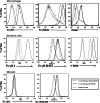Effective antibody therapy induces host-protective antitumor immunity that is augmented by TLR4 agonist treatment
- PMID: 21842208
- PMCID: PMC3517883
- DOI: 10.1007/s00262-011-1090-7
Effective antibody therapy induces host-protective antitumor immunity that is augmented by TLR4 agonist treatment
Abstract
Toll-like receptors are potent activators of the innate immune system and generate signals leading to the initiation of the adaptive immune response that can be utilized for therapeutic purposes. We tested the hypothesis that combined treatment with a Toll-like receptor agonist and an antitumor monoclonal antibody is effective and induces host-protective antitumor immunity. C57BL/6 human mutated HER2 (hmHER2) transgenic mice that constitutively express kinase-deficient human HER2 under control of the CMV promoter were established. These mice demonstrate immunological tolerance to D5-HER2, a syngeneic human HER2-expressing melanoma cell line. This human HER2-tolerant model offers the potential to serve as a preclinical model to test both antibody therapy and the immunization potential of human HER2-targeted therapeutics. Here, we show that E6020, a Toll-like receptor-4 (TLR4) agonist effectively boosted the antitumor efficacy of the monoclonal antibody trastuzumab in immunodeficient C57BL/6 SCID mice as well as in C57BL/6 hmHER2 transgenic mice. E6020 and trastuzumab co-treatment resulted in significantly greater inhibition of tumor growth than was observed with either agent individually. Furthermore, mice treated with the combination of trastuzumab and the TLR4 agonist were protected against rechallenge with human HER2-transfected tumor cells in hmHER2 transgenic mouse strains. These findings suggest that combined treatment with trastuzumab and a TLR4 agonist not only promotes direct antitumor effects but also induces a host-protective human HER2-directed adaptive immune response, indicative of a memory response. These data provide an immunological rationale for testing TLR4 agonists in combination with antibody therapy in patients with cancer.
Figures







References
-
- McLaughlin P, Grillo-Lopez AJ, Link BK, Levy R, Czuczman MS, Williams ME, Heyman MR, Bence-Bruckler I, White CA, Cabanillas F, Jain V, Ho AD, Lister J, Wey K, Shen D, Dallaire BK. Rituximab chimeric anti-CD20 monoclonal antibody therapy for relapsed indolent lymphoma: half of patients respond to a four-dose treatment program. J Clin Oncol. 1998;16(8):2825–2833. - PubMed
-
- Kaminski MS, Estes J, Zasadny KR, Francis IR, Ross CW, Tuck M, Regan D, Fisher S, Gutierrez J, Kroll S, Stagg R, Tidmarsh G, Wahl RL. Radioimmunotherapy with iodine (131)I tositumomab for relapsed or refractory B-cell non-Hodgkin lymphoma: updated results and long-term follow-up of the University of Michigan experience. Blood. 2000;96(4):1259–1266. - PubMed
-
- Cunningham D, Humblet Y, Siena S, Khayat D, Bleiberg H, Santoro A, Bets D, Mueser M, Harstrick A, Verslype C, Chau I, Van Cutsem E. Cetuximab monotherapy and cetuximab plus irinotecan in irinotecan-refractory metastatic colorectal cancer. N Engl J Med. 2004;351(4):337–345. doi: 10.1056/NEJMoa033025. - DOI - PubMed
Publication types
MeSH terms
Substances
Grants and funding
LinkOut - more resources
Full Text Sources
Other Literature Sources
Research Materials
Miscellaneous

